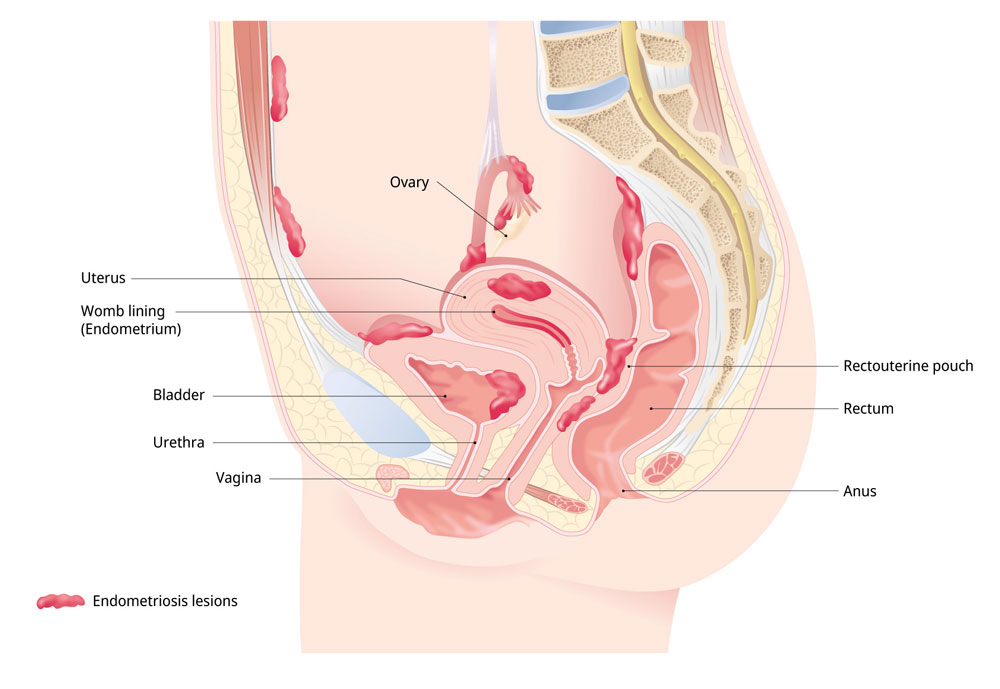Diagnosis and symptoms | Infertility | Treatment | Infiltrating endometriosis | Endometriosis of the sciatic nerve
CAUSES OF ENDOMETRIOSIS
Endometriosis is one of the most common gynaecological conditions, affecting around 1 in 10 women. The symptoms are often not immediately recognised as they may be interpreted as normal pain during menstruation. In endometriosis, cells from the uterine lining – the endometrium -– spread outside the uterine cavity. They can settle on the pelvic peritoneum, ovaries, bladder or intestine, and even on the lungs or kidneys.
Because endometriosis lesions are subject to cyclical changes in hormones, they grow and release neurotransmitters that cause pain in the lower abdomen during the menstrual period. In many women, the pain extends down to their legs or lower back. Sometimes it can feel like lumbago or irritation of the sciatic nerve. Endometriosis can occur at all stages of life and is a chronic but curable condition that may require repeated intervention. The following symptoms can occur in endometriosis:
The following symptoms can occur in endometriosis:
- Pelvic pain that begins a few days before menstruation
- Continual pelvic pain
- Bleeding problems
- Back pain
- Pain during sexual intercourse (dyspareunia) or during gynaecological examinations
- Infertility
- Lack of drive and energy
- Pain during bowel movements or urination (which may be accompanied by blood). These can be signs of an intestinal or bladder condition.
If it is not treated, endometriosis can lead to long-term infertility. For individuals who want to have children, it is therefore important to have any endometrial tissue growing in the area of the ovaries or in the fallopian tubes properly treated.
Laparoscopic surgery is the gentlest and most effective method of treating severe endometriosis. The endometriosis is completely removed in this procedure, while the pelvic organs and their functions are preserved. Removal of the uterus or ovaries is not usually necessary and also not desirable if the individual wants to have children at a later stage.
When endometriosis occurs in the region between the intestine and the vagina, it is known as deep infiltrating endometriosis in the rectovaginal septum. In this case, endometriosis can affect the rectum (the last part of the intestine that leads to the anus), ureters, bladder and even the pelvic nerves that control the rectum, bladder and sexual function.
Extensive endometriosis of the rectum can lead to the following symptoms:
- Intestinal obstruction
- Bleeding from the bladder
- Blockage of the ureters and irreversible kidney damage, and even destruction of the bladder wall
Surgical removal of the endometriosis is necessary in this severe form, along with removal of parts of the organs affected. This can be performed using laparoscopic or open surgery.
Endometriosis can also affect the sciatic nerve and all pelvic nerves, including the obturator nerve (a lumbar nerve) and the femoral (thigh) nerves. Hormone therapy is not effective in endometriosis of the pelvic nerves – it even carries the risk of unnecessarily delaying surgical treatment of the disease. Surgical treatment is necessary to avoid irreversible damage to the nerves leading to motor deficits, particularly raising and lowering the foot. Removal of endometriosis on the sciatic nerve is the most demanding of all pelvic procedures. The use of tiny cameras provides for minimally invasive, highly precise treatment with the best possible protection of the nerves.
Our specialists offer individual consulting and treatments based on the latest medical and scientific knowledge. All forms of endometriosis are treated here, from simple to complex cases. The surgical procedures are almost always performed using laparoscopic surgical techniques.